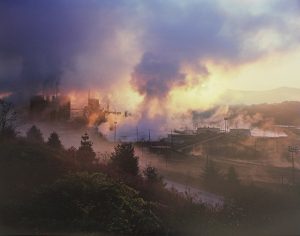
![]() Jeff Rich’s photographic project and accompanying book, Watershed: The French Broad River, published in 2012, chronicles the complexity of a river’s environmental and social ecology. This photograph of the Blue Ridge Paper Mill, the cover image of the book, has been called “a beautiful study of the effects of pollution.”[footnote]Daniel Coburn, “Watershed,” Fraction Magazine, Issue 38. http://www.fractionmagazine.com/review/watershed. Accessed Nov. 30, 2016.[/footnote] Nestled in a green valley and situated on the bank of the river, the factory glows under the golden rays of the morning sun.
Jeff Rich’s photographic project and accompanying book, Watershed: The French Broad River, published in 2012, chronicles the complexity of a river’s environmental and social ecology. This photograph of the Blue Ridge Paper Mill, the cover image of the book, has been called “a beautiful study of the effects of pollution.”[footnote]Daniel Coburn, “Watershed,” Fraction Magazine, Issue 38. http://www.fractionmagazine.com/review/watershed. Accessed Nov. 30, 2016.[/footnote] Nestled in a green valley and situated on the bank of the river, the factory glows under the golden rays of the morning sun.
This is a disturbing image. The clouds emitted by the factory are beautiful, but troubling, given the rise and fall of the environmental fate of the long-polluted Pigeon River. The paper mill has polluted the river for over a century, and its water is not drinkable for downstream communities. Toxic releases to the water are over 100,000 pounds a year.[footnote]“The long struggle for a clean Pigeon River,” 2016. http://cwfnc.org/polluter-accountability/pigeon-river/ Accessed Nov. 30, 2016.[/footnote]For a brief period the river was shaping up to be a success story, as clean-up efforts went forward in the late 1990s. However, regulatory neglect seems to have reversed the brief progress made, and the river is becoming increasingly vulnerable.![]()
But this photograph is less about the river and more about the sky, as the clouds of steam and smoke are discharged from coal-powered boilers into the atmosphere. According to the Organization for Economic Co-operation and Development, the paper industry is the third largest producer of greenhouse gases.[footnote]Henry J. Fair, The Day after Tomorrow: Images of Our Earth in Crisis (Brooklyn, NY: PowerHouse Books, 2010), p. 44.[/footnote] The mill is reputed to be the largest industrial air polluter in the western part of the state, according to federal emissions reporting. In 2015 the state of North Carolina pledged $12 million toward upgrades of some coal boilers and conversion of others to natural gas, with the goal of reducing air pollution; however, given our current political climate and the reversal of environmental gains, the fate of the river is uncertain.[footnote]“The long struggle for a clean Pigeon River,” 2016. http://cwfnc.org/polluter-accountability/pigeon-river/ Accessed Nov. 30, 2016.[/footnote]
Listen to commentary from Kirsten Hoving and Jeff Rich :